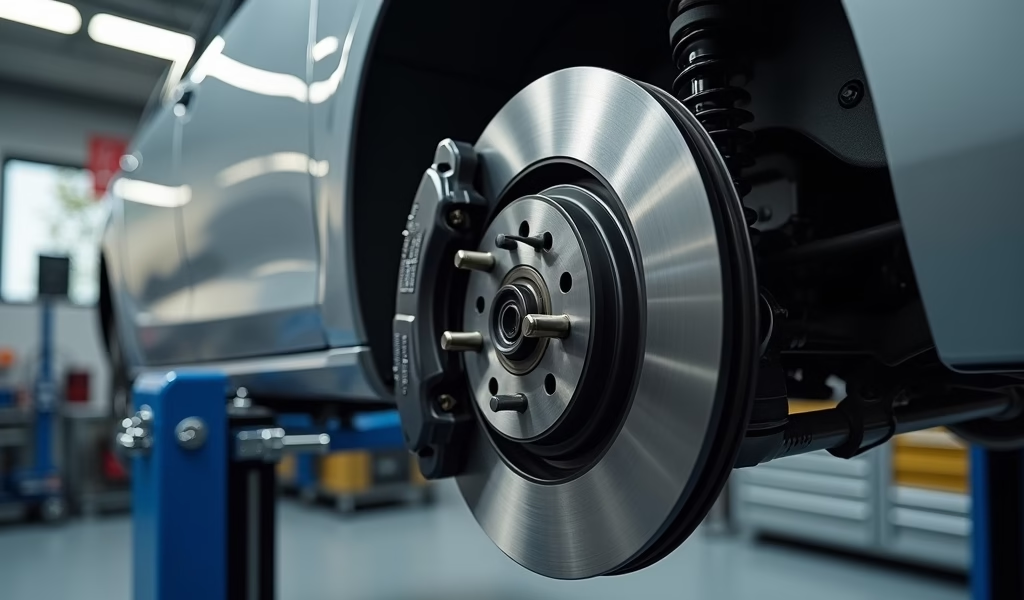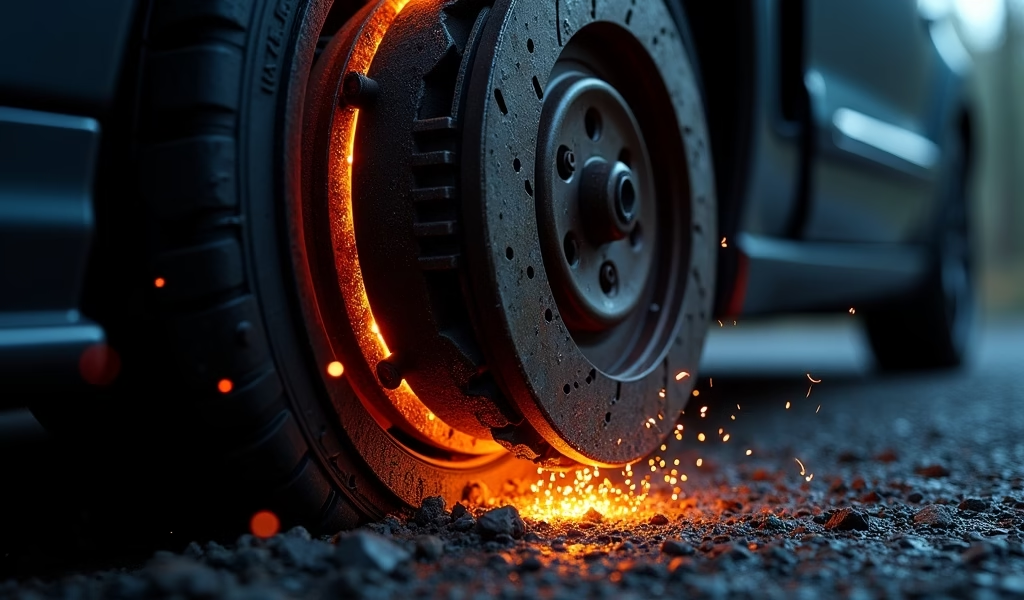Overview
This article presents seven essential brake repair treatments including pad replacement, rotor work, caliper service, fluid maintenance, line repair, and ABS servicing, while explaining warning signs of brake problems and helping readers decide between DIY or professional repairs. The author emphasizes that brake maintenance is a critical safety investment that prevents minor issues from becoming major, expensive problems requiring immediate attention.
Table of Contents
- Understanding Your Brakes: The Science Behind Stopping
- 7 Warning Signs Your Brakes Need Attention
- Treatment 1: Brake Pad Replacement – The First Line of Defense
- Treatment 2: Rotor Resurfacing – Smoothing the Rough Spots
- Treatment 3: Rotor Replacement – When Resurfacing Won’t Cut It
- Treatment 4: Caliper Rebuild or Replacement – The Pressure Masters
- Treatment 5: Brake Fluid Flush – The Lifeline of Your System
- Treatment 6: Brake Line Repair – Protecting Your Hydraulic Highways
- Treatment 7: ABS System Service – High-Tech Helping Hand
- DIY or Professional: Making the Right Choice
- Conclusion: Investing in Safety and Performance
- Frequently Asked Questions
That spine-tingling screech when you hit the brakes isn’t just annoying—it’s your car’s desperate cry for help. As a master mechanic with 20 years under my belt, I’ve seen too many drivers ignore these warning signs until they’re facing a repair bill that makes their eyes water. Your braking system isn’t just another car component; it’s your lifeline on the road.
Whether you’re hearing unusual noises, feeling vibrations, or noticing longer stopping distances, understanding your brake repair options can save you money and, more importantly, keep you safe. In this comprehensive guide, I’ll walk you through the seven most effective brake repair treatments I’ve used throughout my career, helping you make informed decisions about your vehicle’s maintenance needs.
Understanding Your Brakes: The Science Behind Stopping
Before diving into repairs, let’s demystify how your brake system actually works. It’s a beautifully orchestrated mechanical symphony that transforms your foot’s pressure into stopping power.
When you press the brake pedal, it activates a master cylinder that pressurizes brake fluid throughout the system. This hydraulic pressure extends to your wheels, where calipers squeeze brake pads against rotors (in disc brake systems) or push brake shoes against drums (in drum brake systems). This friction creates the stopping force that slows and stops your vehicle.
Modern vehicles typically use disc brakes on the front wheels (and often all four), while some economy cars still use drum brakes on the rear. Disc brakes provide superior stopping power and heat dissipation but come at a higher cost. The Automotive Brake Service Council reports that understanding this basic functionality helps drivers make better maintenance decisions.
7 Warning Signs Your Brakes Need Attention
Your brakes talk to you long before they fail completely. Here are the warning signs I tell my customers to watch for:
- Squealing, grinding, or metallic screeching noises
- Brake pedal feels soft, spongy, or goes too far toward the floor
- Vibration or pulsation when braking
- Vehicle pulls to one side during braking
- Brake or ABS warning light illuminates on dashboard
- Burning smell while driving
- Increased stopping distance or reduced braking effectiveness
If you notice any of these symptoms, don’t wait. A small brake issue can quickly cascade into major system damage, turning a $200 pad replacement into a $1,000+ repair bill. Let’s explore the treatments that might be necessary.

Treatment 1: Brake Pad Replacement – The First Line of Defense
Brake pads are the workhorses of your braking system. They’re designed to wear down gradually—a sacrificial component that protects the more expensive parts of the system.
When you hear that telltale squealing, it’s often your brake pad wear indicators doing their job. These small metal tabs start contacting the rotor when your pads wear down to about 3-4mm thickness, creating an audible warning before metal-on-metal damage occurs.
Replacing pads is relatively straightforward: removing the wheels, extracting the old worn pads from the calipers, and installing new ones. While doing this job, I always clean and lubricate the caliper hardware and check related components for signs of wear.
You’ll typically spend between $100-$300 per axle depending on your vehicle and pad quality. Premium ceramic pads cost more upfront but often last longer and produce less dust than organic or semi-metallic alternatives. For most daily drivers, quality semi-metallic pads offer the best balance of performance, longevity, and value.
Expect good quality pads to last anywhere from 30,000-70,000 miles, though this varies dramatically based on driving habits, vehicle weight, and environmental conditions. City drivers with frequent stops will need replacements more often than highway commuters.
Treatment 2: Rotor Resurfacing – Smoothing the Rough Spots
Like a skilled sculptor reshaping clay, rotor resurfacing (also called “turning” or “machining”) removes a thin layer of metal from the rotor surface to restore smoothness and parallelism.
This process works well for rotors with minor warping, light scoring, or surface rust that haven’t yet reached minimum thickness specifications. The rotor is mounted on a lathe that precisely cuts away damaged surface material, creating a fresh, even surface for the brake pads to contact.
The primary benefit is cost savings—typically $15-$40 per rotor compared to full replacement. However, each resurfacing removes material and reduces the rotor’s heat capacity. Most rotors can only be resurfaced once or twice before becoming too thin.
I’ll be straight with you: I’m resurfacing rotors less frequently these days. As rotor prices have decreased while labor costs have increased, the value proposition has shifted toward replacement. Many manufacturers now make rotors so precisely that they’re considered wear items like pads.
When a customer brings in a car with moderately worn rotors, I usually recommend replacement if:
- The rotors are already close to minimum thickness
- They show signs of cracking or severe heat damage
- They have deep grooves that would require excessive material removal
- The cost difference between resurfacing and new rotors is minimal
That said, for light surface issues on thick, quality rotors, resurfacing remains a cost-effective option that can provide excellent results when done properly.
Treatment 3: Rotor Replacement – When Resurfacing Won’t Cut It
When damage goes beyond surface-level, it’s time for new rotors. Like replacing worn shoes rather than just adding new insoles, new rotors provide a fresh start for your braking system.
You’ll need rotor replacement when they’re below minimum thickness (specified by manufacturer), have deep grooves or scoring, show signs of cracking, have excessive rust, or have been previously resurfaced to their limit. I always check thickness with a micrometer and inspect for cracks—especially near the cooling vanes and mounting surface.
Modern rotors come in several varieties:
- Standard blank rotors: Cost-effective and suitable for most drivers
- Drilled rotors: Feature holes for improved heat dissipation and water dispersal
- Slotted rotors: Have channels that help remove gas and dust while providing better initial bite
- Drilled and slotted: Combine both features for high-performance applications
For most daily drivers, quality blank rotors provide excellent performance at reasonable prices—typically $30-$75 per rotor for most vehicles, plus labor if professionally installed. Performance rotors can cost significantly more but rarely provide noticeable benefits in normal driving.
When replacing rotors, I always recommend replacing pads simultaneously. The fresh friction surfaces work together to provide optimal braking performance and longevity. Proper torquing of lug nuts and caliper bolts is essential—something I’ve seen DIYers frequently overlook.
Treatment 4: Caliper Rebuild or Replacement – The Pressure Masters
If brake pads and rotors are the shoes and dance floor, calipers are the feet that apply the pressure. When these crucial components falter, your entire braking system suffers.
Caliper problems typically manifest as uneven pad wear, vehicle pulling to one side when braking, leaking brake fluid around wheels, or brakes that don’t release properly. These issues require prompt attention to prevent cascading damage to other components.
You have two primary options for addressing caliper issues:
- Rebuild: Disassembling the caliper, replacing seals, pistons, and hardware, then reassembling
- Replacement: Installing an entirely new or remanufactured caliper unit
Twenty years ago, I rebuilt calipers frequently. Today, with the availability of quality remanufactured units at competitive prices, rebuilding rarely makes economic sense except for classic cars or specialized applications. A quality reman caliper typically costs $100-$300 each including parts and labor, while rebuilding might save $30-50 but takes significantly more time.
After caliper work, the system must be properly bled to remove air. I always check that caliper slide pins move freely and apply the appropriate lubricant to ensure smooth operation. This small detail often gets overlooked but can dramatically affect brake performance and pad life.

Treatment 5: Brake Fluid Flush – The Lifeline of Your System
Brake fluid is perhaps the most overlooked component in the system, yet it’s literally the lifeblood that transforms pedal pressure into stopping power.
Unlike engine oil or coolant, brake fluid doesn’t “burn up” or evaporate—but it does deteriorate. Brake fluid is hygroscopic, meaning it absorbs moisture from the air over time. This moisture lowers the fluid’s boiling point (bad for performance) and promotes internal corrosion of brake components.
A proper flush removes old fluid from the reservoir and brake lines, replacing it with fresh fluid that meets manufacturer specifications. The system is then bled to remove air bubbles that would create a spongy pedal.
Most manufacturers recommend replacing brake fluid every 2-3 years regardless of mileage. I’ve seen the consequences of neglect firsthand: corroded calipers, damaged master cylinders, and ABS modules ruined by contaminated fluid—all preventable with a simple, relatively inexpensive maintenance procedure.
A professional brake fluid flush typically costs $80-$150, making it one of the most cost-effective preventative maintenance procedures for your braking system. I recommend using only fluid that meets or exceeds your vehicle manufacturer’s specifications, typically DOT 3 or DOT 4 for most passenger vehicles.
NHTSA studies confirm that maintaining clean brake fluid significantly reduces the risk of hydraulic failure in emergency stopping situations.
Treatment 6: Brake Line Repair – Protecting Your Hydraulic Highways
Like arteries carrying blood through your body, brake lines carry the vital fluid that powers your braking system. When these pathways fail, the results can be catastrophic.
Brake lines commonly fail due to external corrosion (especially in regions using road salt), physical damage from road debris, aging and cracking, or improper previous repairs. A compromised line can leak fluid, resulting in partial or complete brake failure—one of the most dangerous automotive malfunctions.
Minor damage sometimes allows for sectional repair, where only the damaged portion is replaced. However, I generally recommend complete line replacement for the affected circuit—it’s safer and more reliable in the long run.
When replacing lines, you have material options:
- Standard steel lines: Cost-effective but more prone to corrosion
- Stainless steel lines: More expensive but highly corrosion-resistant
- Flexible lines (connecting to calipers): Need replacement if cracked or bulging
For vehicles in the rust belt or those I expect to be on the road for many more years, I often recommend the upgrade to stainless steel lines. They cost more initially but virtually eliminate the risk of corrosion-related failure.
Expect to pay $150-$400 for brake line replacement, depending on the extent of work and materials used. Labor costs are significant due to the technical nature and safety implications.
Treatment 7: ABS System Service – High-Tech Helping Hand
The Anti-lock Braking System represents the brainy side of your braking system—the electronic guardian that prevents wheel lock-up during emergency stops, allowing you to maintain steering control while braking hard.
Common ABS issues include illuminated warning lights, pulsating brake pedal during normal braking, strange noises, reduced braking effectiveness, and sensor failures. These problems require electronic diagnostics using specialized scan tools to read trouble codes and identify specific issues.
Repairs may include sensor replacement, module reprogramming, pump rebuilding or replacement, or wiring repairs. The complexity of modern ABS systems means this is rarely a DIY-friendly repair area.
While dealers often have the most up-to-date equipment and training for ABS systems, many quality independent shops have invested in the necessary diagnostic tools. I recommend comparing quotes, as dealer prices can be significantly higher for essentially the same service.
ABS repairs vary widely in cost, from approximately $100-$200 for a sensor replacement to $1,000+ for module or pump replacement. Diagnostic fees typically range from $75-$150 but are worth every penny for accurately identifying the root cause before parts replacement.
DIY or Professional: Making the Right Choice
I respect DIY enthusiasts—I started as one myself. Some brake jobs are reasonably accessible for home mechanics with proper tools and knowledge:
- Most DIY-friendly: Brake pad replacement, fluid checks
- Moderate DIY difficulty: Rotor replacement, basic fluid flush
- Professional recommended: Caliper work, brake line replacement, ABS service
If you’re considering the DIY route, invest in a quality service manual specific to your vehicle. Remember that mistakes in brake work can have serious safety implications. Always torque fasteners to specifications, use the correct brake grease (never use standard lubricants on brake components), and test thoroughly before returning to normal driving.
For most drivers, professional service provides peace of mind, proper disposal of old parts and fluids, and often a warranty on parts and labor. Ask your mechanic about their brake service warranty—most reputable shops stand behind their work for at least 12 months.
Conclusion: Investing in Safety and Performance
Your vehicle’s braking system isn’t just about stopping—it’s about controlling one of the largest daily safety risks we face. Every time you press that brake pedal, you’re trusting your life and the lives of others to a system of hydraulics, friction materials, and electronics working in perfect harmony.
Regular inspection and timely maintenance aren’t expenses—they’re investments in safety, performance, and ultimately cost savings. Many major brake repairs start as minor issues that were ignored until they cascaded into bigger problems.
Whether you choose DIY maintenance or professional service, understanding these seven treatment options empowers you to make informed decisions. Your brakes deserve the same care and attention you’d give any safety-critical system.
Remember: when it comes to brakes, the cost of prevention is always lower than the cost of failure. Drive safely, listen to what your vehicle is telling you, and don’t compromise when it comes to the system that brings you safely to a stop.
Frequently Asked Questions
How often should brake pads be replaced?
Most brake pads need replacement every 30,000-70,000 miles depending on driving habits and pad quality. Listen for squealing noises and pay attention to reduced braking performance as indicators.
Is it necessary to replace rotors with pads?
Not always, but it’s often recommended if rotors show significant wear, scoring, or are below minimum thickness. Replacing both components together provides optimal braking performance and longevity.
How much does a complete brake job typically cost?
A complete brake job (pads, rotors, and hardware) typically costs $250-$500 per axle depending on vehicle type and parts quality. Luxury and performance vehicles can cost significantly more.
What causes brake rotors to warp?
Rotors don’t actually warp but develop uneven deposits and thickness variations from excessive heat, improper torquing of lug nuts, or low-quality materials. Proper cooling after hard braking helps prevent this condition.
Can I drive with grinding brakes?
No, grinding indicates metal-on-metal contact that’s causing expensive damage with every application. Have your vehicle towed or drive cautiously to the nearest repair shop immediately to prevent further damage.


Pingback: Brake Shop: Top 10 Car Maintenance Tips - knowsyourcar.com